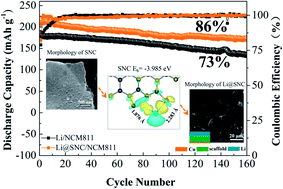Sulfur–nitrogen co-doped porous carbon nanosheets to control lithium growth for a stable lithium metal anode†
Abstract
Lithium (Li) metal is a promising anode material for next-generation rechargeable batteries. However, their limited lifespan caused by uncontrollable Li deposition and dendrite growth impedes the commercial application of Li metal batteries. Here, we demonstrate that sulfur–nitrogen co-doped porous carbon nanosheets (SNC) can serve as perfect Li plating scaffolds for a dendrite-free lithium metal anode (LMA). Through first principles calculation, it is found that the higher Li-s and S-p/N-p orbital hybridization degree results in a stronger adsorption ability of Li atoms, which suggests a synergistic effect of S, N co-doping. We demonstrate that SNC and Li have strong binding energy and short bond length, which are beneficial for the uniform growth of Li and dendrite inhibition. When applied as the anode for Li metal batteries, the SNC based LMA exhibits high cycling stability and excellent rate capability in a half cell. A full cell with the cathode LiNi0.8Co0.1Mn0.1O2 exhibits a capacity retention of 86% after 160 cycles, much better than that with a Li foil anode (73%). This work may shed light on the design of advanced LMAs by employing heteroatom doped functionalized carbon scaffolds.

- This article is part of the themed collection: 2019 Journal of Materials Chemistry A HOT Papers


 Please wait while we load your content...
Please wait while we load your content...